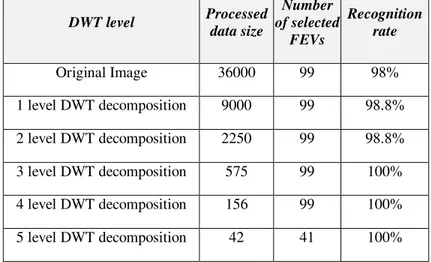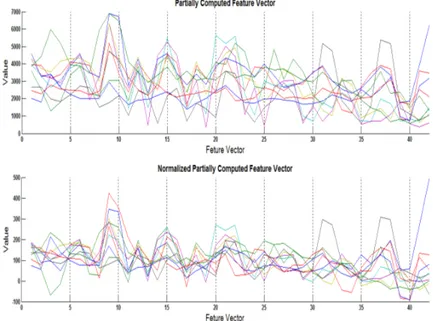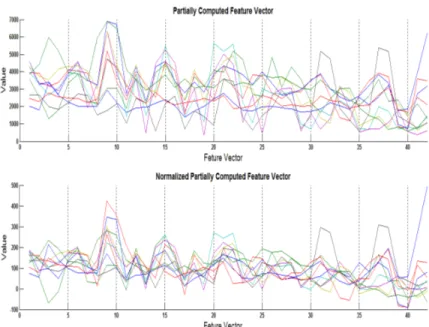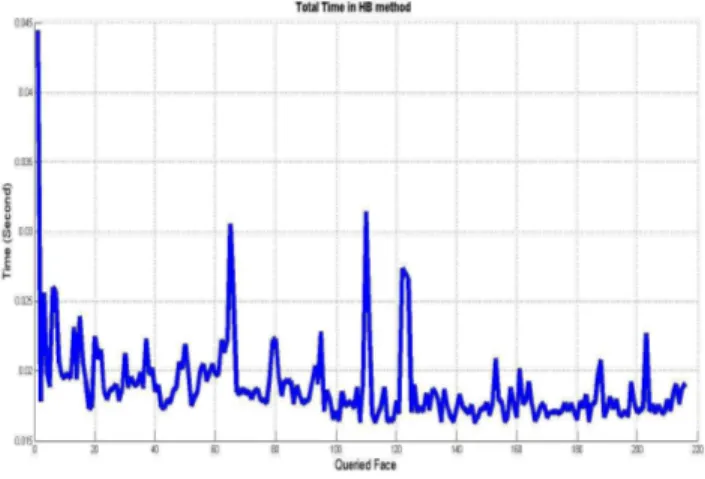59
Volume 7 Issue 4 December 2016 ISSN: 2319 - 1058
System for Real Time Environment
Dr.Matheel E. Abdulmunem
Department of Computer Science University of Technology, Baghdad, Iraq.
Fatima B. Ibrahim
Department of Information and Communication Engineering
Al-Khawarizmy College of Engineering,University of Baghdad,Baghdad, Iraq.
Abstract- Face recognition has been an important and active research field because it offers many applications. A real time face recognition algorithm is proposed in this paper based on the use of Haar wavelet decomposition and the principle of Principle Component Analysis (PCA). The aim of this paper is to reduce the algorithm complexity to achieve the time requirement of real time. To get better recognition rate, feature normalization method is proposed based on the computation of mean and standard deviation for the partially feature extracted. Also the faces are classified using the proposed MCF algorithm. The system accuracy is reaches to 100% with time consumed about 0.03 second.
Keywords – Face Recognition, Eigenfaces, Haar wavelet, Real time.
I.INTRODUCTION
The first generation of biometric systems was developed over the last decades. These systems can be found in applications of a wide range of civilian and commercial systems. The second generation of biometric systems can emerge in potentially new biometric feature added value from soft biometric and effective use of multiple biometric features. With the development of smart sensing technologies a wide range of applications and technologies have been appeared and come in the area of research [1]. Face observation is a significant part of the skills of human perception system and is a routine task for humans, whereas construction an analogous computer system is yet an outstanding research area. The earliest work on face recognition can be mapped out back at least to the early 1950s [2].
A face recognition system may require accomplishment of identification and verification or both of them depending on the application requirements and aims. Identification is a multi-class task where the input is recognized to be known or unknown then assigned to a specific class. Verification is easier, it is a two-class task where the input is recognized to be known or unknown only [3, 4]. In face recognition, the facial image is representing in a feature vector obtained from several methods by one or more levels of extraction. Feature vectors should have main aspects. The most important one is that it should give a uniqueness view for each face. What makes other image of the same face near that vector and far away from other faces. These vectors are used to be matched with the data base to compute the similarity of the face with the database [5].
II.PROPOSED ALGORITHM
Discrete Wavelet Transform (DWT) has a good indication in both feature extraction and compression. Applying 2D DWT on image breaks it down into four sub-bands which are LL corresponding the effectiveness of applying low pass filter twice on this region, HL corresponding the effectiveness of applying high pass filter followed by low pass filter on this region, LH corresponding the effectiveness of applying low pass filter followed by high pass filter on this region and HH corresponding the effectiveness of applying high pass filter twice on this region.
HL, LH, HH sub-bands are carrying the details of the information of the frequencies. LL sub-band is carrying the approximation information of the frequencies that represent the most useful information for both feature extraction and compression fields. It is useful to apply second, third and another level of decomposing on the LL sub-band. The suggested method has been supposed to compress the face image up to 5 level decomposition using discrete Haar wavelet transform.
This suggestion has been well-thought-out to explain the aspect of Haar wavelet transform of simple computation and fast calculation. Also memory efficient aspect of needless temporary array in calculation is a good working factor. Simple addition and subtraction are enough to perform haar wavelet transform without the need for the convolution process.
Then these partially features obtained are normalized by a method depends on the computation of the Mean (µ) and the standard Deviation (std) ( ) before applying Eigen faces algorithm. Its work is similar to the work of standard min-max normalization but with respecting to the statistical features of the set of data. This method aims to reduce the error that comes from the original face images due to its lighting and brightness conditions.
There is an assumption to estimably determined mean and std for the whole data set, which are used with the sample mean and sample std to compute the normalized sample.
With this method, the accuracy of recognition is superior clearly. The features of the same class (person) are appeared to be more correlated to each other when applying OMOS method. This correlation supports Eigen Faces algorithm, as it depends on analyzing the variances of different features. Algorithm (1) is explained the suggested OMOS transform.
Algorithm (1): On Mean On Standard (OMOS) algorithm
Input: X vector to be normalized, est estimated standard deviation value, em estimated mean value.
Output: normalized vector.
Begin
Step1: compute m mean value by:
Step2: compute st standard deviation value by:
Step3: normalize the vector X where i=1..n, by:
End.
After recognition, a face classification algorithm is suggested inspiriting by the nearest neighbor approach as a classification method and K-mean method as a clustering method that computing the mean value to the feature Eigen faces for each individual to represent the mean of the class. Algorithm (2) has been demonstrated the complete steps of classification.
61
Volume 7 Issue 4 December 2016 ISSN: 2319 - 1058
Input: omg_weight weight of each feature face, N total number of training images for all individuals, M number of samples per individual.
Output: Classes of faces obtained from training dataset representing by MC matrix.
Begin
Step1: For initial i= 1 to (N/M) do step 2 - 7
Step2: initialize tepm = M*i
Step3: for initial j = 0 to M-1 repeat
Step4: col (j)= temp – j;
Step5: go to step 3.
Step 6: compute the elements of MC by
Step 7: go to step 1
End.
III.EXPERIMENT AND RESULT
Matlab® 2010a is used for testing the system based on FACES94 database. FACES94 database contains facial images of 153 person’s classified as male, female and male_staff. For each person 20 images are taken in the time of that he/she is spoken and make some slight difference to position. Images are color images of resolution 180×200. As a first step in work grayscale images are obtained from these colored images.
The selection of Haar is linked to its simplicity and speed. These Haar properties’ make it suitable to implement on low computational and real time systems. The low computational method to reduce computation of Eigen faces. The reduction has reached to 88%. Figure (1) shows the reduction curve. The reduction of data is near to exponential decrease using the LL sub-band decomposition in each step.
The method complexity is , where m is the size of data to input to the Eigen faces algorithm which it is array of two dimension. The reduction of array is done by Haar wavelet transform gradually so the computations of feature Eigen faces and feature Eigen values have been decreased meaningfully level by level, the size of the
0 5000 10000 15000 20000 25000 30000 35000 40000
0 1 2 3 4 5
D a ta s iz e
DWT decomposit ion level
Reduction Data size
dat a size
Expon. (dat a size)
62
Volume 7 Issue 4 December 2016 ISSN: 2319 - 1058
original facial image is 200×180 that need to compute Eigen value and Eigen vector for them which is it high computational complexity.by our approach of reduction the size of the input data to 7×6 input data by five level of Haar wavelet decomposition the computation complexity is reduced significantly.
Also the reduction has an effect on the selected feature Eigen values number and the stored feature database when all the factors are minimized. The recognition rate is improved also level by level. Although, recognition rate reaches to 100% from the third level of decomposition but the computation complexity decreased clearly by another levels of decomposition. Table (1) shows this information.
Table 1- The effect of reducing input features for FEF algorithm over the number of selected FEVs in HB method.
DWT level Processed
data size
Number of selected
FEVs
Recognition rate
Original Image 36000 99 98%
1 level DWT decomposition 9000 99 98.8% 2 level DWT decomposition 2250 99 98.8%
3 level DWT decomposition 575 99 100%
4 level DWT decomposition 156 99 100%
5 level DWT decomposition 42 41 100%
For 5 level of DWT decomposition, the feature mean image values have been presented in figure (1) and the reduced feature Eigen faces corresponding for 41 feature Eigen values have been presented in figure (3). Figure (4) shows the values of the feature Eigen vectors. It seems that the feature Eigen values are decreased very fast which means that the selecting smaller number of values to represent the feature face space is reasonable. The weight of each training image in the training set in the feature face space is represented in figure (5).
63
Volume 7 Issue 4 December 2016 ISSN: 2319 - 1058
Table 2- Recognition rate with FEFs number per different number of trained images in HB method. Number of images
used in training (per individual)
Number of images used in testing (per individual)
Number of FEFs Recognition rate (%)
1 12 9 100
2 12 11 100
5 12 41 100
10 10 41 100
0 1000000 2000000 3000000 4000000 5000000 6000000
0 10 20 30 40 50
Feature Eigen Value Values of Reduced FEVs
The recognition rate without applying any normalization transform is 98%. After applying the partially feature extracted by Haar wavelet transform to the proposed OMOD transform the recognition ups to 100%.
OMOS normalization is attempting to normalize the distribution of the whole data to a desired estimated mean and desired estimated standard deviation. Figure (6) shows that the set of partially feature vector before and after applying to OMOS normalization with the HB method. As seen from the figure (6), that the effect appears on the whole set to be in smaller range keeping the value of each vector separated from each other.
The faces have been classified to a number of classes equal to the number of individuals in the training dataset using the suggested MCF algorithm. Experiments have been founded to show efficient results of 100% right classification. Distance error of each individual to the center of class is presented in figure (7). A threshold value is used to compare the distance with each center of class to decide whether the queried face belongs to class or not. The classification of authenticated faces to the corresponding class has been shown in figure (8).
Figure 6. OMOS normalization on features of HB method.
Figure 7. Distance error of each queried face to
65
Volume 7 Issue 4 December 2016 ISSN: 2319 - 1058
The time consumed by the algorithms is relatively short that they can be suitable to be considered as a soft real time algorithms. The time is perceived in three points of view. The time consumed in sensor nodes to partially extract face features, the time to compute the feature Eigen faces and the total time to completely extract the features of the face are considered. The results on 210 trails are considered to study the time factor of the algorithms. The total time is the summation of the above two times. It is computed by:
… (1)
In figure (9) the partially feature extraction time ( ) is shown for HB proposed method. The time to compute the feature Eigen faces is shown in figure (10) while the total time total time for the method which is the summation of the two previous times is shown in figure (11) that is in a range 0.025 second. This time is acceptable in real time systems as a real time face recognition system.
Figure 6. OMOS normalization on features of HB method.
Figure 9. Time to compute Haar features in HB
IV.CONCLUSION
This paper has presented a face recognition method working on real time environment. It is depending on hybrid method of DWT and PCA principles to both recognition and compression ideas. Using Haar wavelet transform is improving the recognition accuracy. Also the proposed OMOD normalization transform plays a significant role in improving the accuracy of the recognition to reaches to 100%. The face classification of the system is approved by its simplicity, high accuracy and high speed to be used in real time system.
The high speed, good accuracy of the system makes it work in addition to real time, to be suitable for wireless multimedia sensor network applications and the low cost hardware implementation.
The method can be executed with Fisher faces as a future work for more accurate recognition.
REFERENCE
[1] A. Jain, and A. Kumar, "Biometrics of Next Generation: An Overview", Second Generation Biometrics (E. Mordini and D. Tzovaras, Eds.), Springer, 2010.
[2] W. Zhao, R. Chellappa, P. Phillips, A. Rosenfeld, “Face Recognition: A Literature Survey”, ACM Computing Surveys, Vol. 35, No. 4, pp. 399–458, December 2003.
[3] A. Samani, “Automatic Face Recognition using stereo images”, PhD thesis, University of Sheffield, Sheffield, UK. 2006.
[4] A. Joshi, A. Deshpande, “Review of Face Recognition Techniques”, International Journal of Advanced in Computer Science and Software Engineering, 5(1). pp: 71- 75, 2015.
[5] S. Nikan, “Human Face Recognition under Degraded Conditions”, PhD thesis, Department of Electrical and Computer Engineering, University of Windsor, Windsor, Ontario, Canada, 2014.
[6] M. Turk and A. Pentland, “Eigenfaces for recognition”, Journal of Cognitive Neuroscience, 3(1), pp:71-86, 1991.
[7] D. Georgescu, “Real-Time Face Recognition System Using Eigenfaces”, Journal of Mobile, Embedded and Distributed Systems, vol. III, no. 4, pp: 193-204, 2011.
[8] S. Jain and D. Bhati,’ “Face Recognition Using ANN with Reduce Feature by PCA in Wavelet Domain”, International Journal of Scientific Engineering and Technology, 2(6), pp: 595-599, 2013.
67





